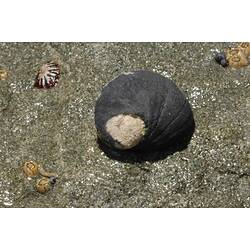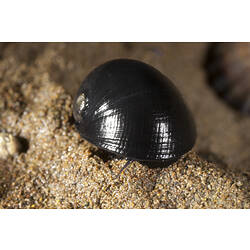General Description
Black shell. Flattened spire with expanded final whorl (body whorl). Shell mostly smooth but has very fine, almost indistinguishable, spiral lines, more than 30. Large, semicircular aperture with white inner lip. Operculum (shelly flap covering the shell aperture) black and globose. Shell up to 3 cm long. Can be difficult to distinguish from Nerita melanotragus which is externally very similar. The most obvious difference is the different colour and shape opercula and the colour of the inner lip.
Biology
Black Nerites are grazers, feeding on thin microalgae films on rock surfaces. They are often found in high numbers, forming dense clusters of individuals. They are thought to live for around 3 years. Black Nerites have two sexes and internal fertilisation. Females deposit egg capsules, which are white, slightly elongated domes, on the underside of stones in rock pools. These egg capsules contain up to 40 eggs and hatch planktonic larvae which can travel quite long distances before settling and metamorphosing. Until 2007 all Black Nerites in Australia were called Nerita atramentosa, but now two species with different but overlapping ranges are recognised. em>Nerita atramentosa occurs from New South Wales to Western Australia while the other species, Nerita melanotragus, occurs from Queensland to South Australia.
Distribution
Southern mainland Australia and Tasmania.
Habitat
Mid to high intertidal areas of rocky shores.
More Information
-
Animal Type
-
Animal SubType
-
Brief Id
Round black shell, black operculum.
-
Colours
Black, White
-
Habitats
-
Diet
Herbivore
-
Diet Categories
Algae
-
Endemicity
-
Commercial
No
-
Conservation Statuses
CITES: Not listed, FFG Threatened List: Not listed, DSE Advisory List: Not listed, IUCN Red List: Not listed
-
Depths
Shore (0-1 m), Shallow (1-30 m)
-
Water Column Locations
On or near seafloor
-
Taxon Name
-
Scientific Author
Reeve, 1855
-
Common Name
Black Nerite
-
Phylum
-
Subphylum
-
Superclass
-
Class
-
Subclass
-
Superorder
-
Order
-
Suborder
-
Superfamily
-
Family
-
Subfamily
-
Genus
-
Subgenus
-
Species Name
atramentosa




